|
|
|
|
|
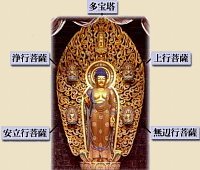
Four Bodhisattva Carved in Halo.
From Risshō Kosei-kai 立正佼成会,
a Buddhist organization founded in
1938, that combines the wisdom of the Lotus Sutra and the core teaching of Shaka Buddha (Historical Buddha).
Based in Tokyo, with worldwide communities. Photo of grouping two.
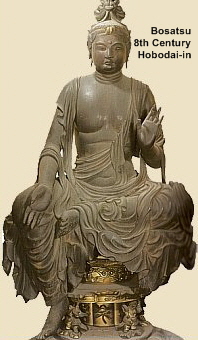
|
|
 FOUR GREAT BODHISATTVA FOUR GREAT BODHISATTVA
OF COMPASSION AND MERCY

Japanese = Shi Dai Bosatsu; Chinese = Sì Dà Púsà
Bosatsu 菩薩 (Japanese), Bodhisattva (Sanskrit)
From the Traditions of Mahayana Buddhism
This is a Side Page.
Return to Main Bodhisattva Page
Throughout Asian, there are four widely revered Bodhisattva, each symbolizing different aspects of Buddhist belief and practice, and each with its own individual cult of veneration. The most common grouping includes Kannon Bosatsu (boundless compassion), Monju Bosatsu (wisdom), Fugen Bosatsu (praxis, or practice), and Jizō Bosatsu (vast patience and salvation from suffering). Among the four, the most widely venerated throughout Asia is Kannon, the God/Goddess of Mercy (Compassion). The group of four first appeared in the Lotus Sutra, but the group itself is not an object of worship. Indeed, the four rarely appear together as a group in Japanese artwork except in the mandala paintings and halo (kōhai 光背) carvings of the Esoteric sects.
Technically speaking, compassion (Skt. = Karuna; Jp. = Jihi 慈非) is the defining characteristic of all Bosatsu, who, by definition, have willingly delayed their entry into Nirvana -- out of compassion -- to save the vast multitude of souls still caught in the wheel of karmic rebirth, the cycle of suffering. This grouping of four is thus arbitrary, and its members can vary. It refers simply to four of the most venerated Bosatsu in the Asian region, and is based on both scriptural sources and changing popularity.
In the centuries following Buddhism’s introduction in India around 500 BC, moreover, a system of vows was developed -- the 48 Vows of the Bodhisattva -- for those seeking to achieve the Bodhisattva state. The vows differ somewhat among the Tibetan, Chinese, and Japanese traditions, but all originated from the vows taken and then dutifully fulfilled by Hōzō Bosatsu (who then becomes Amida Buddha).
In addition to compassion, there are six perfections (Skt. Parmitas) that a Bodhisattva must cultivate in order to attain Buddhahood, to which four more perfections were added in later times:
- Generosity (Skt. Dana-paramita); selfless and impartial generosity
- Discipline (Skt. Shila-paramita); observance of the ethical regimen
- Patience (Skt. Kshanti-paramita); patient endurance of difficulties
- Energy (Skt. Virya-paramita); zealous energy in perseverance
- Meditation (Skt. Dhyana-paramita); mindful absorption in meditation
- Wisdom (Skt. Prajna-paramita); wisdom of transcendent insight
Four more perfections were added in later times:
- Right method (or means)
- Vows
- Manifestation of 10 powers
- True understanding of all dharmas (laws)

Four Great Bodhisattva 四大菩薩
There are various groupings of the four.
GROUPING ONE. As appearing in the Lotus Sūtra 法華經 (T 262.9.40a24)
- Miroku Bosatsu (Skt. = Maitreya)
- Monju Bosatsu (Skt. = Mañjuśrī)
- Kannon Bosatsu (Skt. = Avalokitêśvara)
- Fugen Bosatsu (Skt. = Samantabhadra)
GROUPING TWO. Another list appears in the 從地踊出 chapter of the Lotus Sūtra 法華經 (T 262.9.40a24). These four are largely forgotten among the Japanese people, but still found in artwork of the Esoteric sects (see photo at top of page).
- Jōgyō 上行 (Skt. = Viśiṣtacāritra, Chn. = Shàngxíng). Trans. "excellent practices/behavior."
- Muhen Gyō 無辺行 (Skt. = Anantacāritra, Chn. = Wúbiānxíng). Trans. "unlimited practice."
- Jōgyō 浄行 (Skt. = Viśuddhacāritra, Chn. = JìngXíng). Trans. "practice purity."
- Anryūgyō 安立行 (Skt. = Supratiṣṭhitacāritra, Chn. = ānlì xíng). Trans. "stable practice."
<Source: Both lists from the Digital Dictionary of Buddhism (sign in with user name = guest)
GROUPING THREE. Another list appears in Louis Frederic’s Buddhism (Flammarion Iconographic Guides) , page 151: "Esoteric Buddhism recognizes Four Great Bodhisattvas or 'Great Acolytes' (Mahaparivara, great entourage), who are the symbols of the virtues of the Great Solar Buddha Vairocana (aka Dainichi Buddha). , page 151: "Esoteric Buddhism recognizes Four Great Bodhisattvas or 'Great Acolytes' (Mahaparivara, great entourage), who are the symbols of the virtues of the Great Solar Buddha Vairocana (aka Dainichi Buddha).
- Southeast. Samantabhadra (J = Fugen), represents the merits of the 'heart of Bodhi.'
- Northeast. Maitreya (J = Miroku), who represents the great compassion of the Buddha.
- Southwest. Mañjuśrī (J = Monju), who represents wisdom and the merit of the teaching of the law.
- Northwest. Sarvanīvaraṇaviṣkambhin (J = Jo Kaishō Bosatsu 除蓋障菩薩, C = Chú Gàizhàng Púsà), a form of Kannon who represents the merits resulting from the destruction of obstacles on the path of the Bodhi."
Note. The Digital Dictionary of Buddhism says this about Jo Kaishō Bosatsu: "The chief object of veneration in the Removal of Hindrances group of the Garbhadhātu maṇḍala in Esoteric Buddhism (Mikkyō 密教). He appears prominently in a number of texts, including the Ratnamegha-sūtra 寶雲經, where he poses 102 questions to the Buddha. Also written 除一切蓋障菩薩, 降伏一切障礙菩薩, and 棄諸陰蓋菩薩。 〔除蓋障菩薩所問經, 大日經, 大日經疏〕
GROUPING FOUR. Four Famous Mountains in China 四大名山 (C = Sìdà Míngshān, J = Shidai Myōsan). Also Four Famous Mountains of Buddhism (C = Sìdà Fójiào Míngshān 四大佛教名山. J = Shidai Bukkyō Myōsan). This grouping is very similar to GROUP ONE, but here Jizō Bosatsu replaces Miroku Bosatsu. However, this is easily understood if we recall that Jizō is a substitute for Miroku. Indeed, Jizō promises to unceasingly fulfill Miroku’s tasks in the eons-long interval between the death of the Historical Buddha and the arrival of Miroku (the Future Buddha). Miroku is scheduled to arrive, according to Japan’s Shingon 真言 sect of Esoteric Buddhism, about 5.6 billion years from now, to bestow universal salvation on all beings. During this interval, Jizō serves as Miroku’s replacement. Each of the four Bodhisattva in this group are introduced below.
- Monju (Skt. = Mañjuśrī). Presides over the element wind/air/ether. Mt. Wutai (J = Godai)
- Kannon (Skt. = Avalokitêśvara). Presides over the element water. Mt. Pǔtuó (J = Fudaraku)
- Fugen (Skt. = Samantabhadra). Presides over the element fire. Mt Éméi (J = Gabi)
- Jizō (Skt. = Kṣitigarbha). Presides over the element earth. Mt. Jǐuhuá (J = Kukesen)

FOUR BODHISATTVA OF
CHINA’S FOUR FAMOUS MOUNTAINS
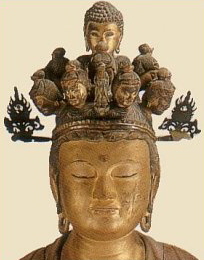  1. Kannon Bosatsu 1. Kannon Bosatsu
Jp. = Kannon Bosatsu 観音菩薩
Chn. = Guānyīn Púsà 観音菩薩 Guanyin
Skt. = Avalokitêśvara अवलोकितेश्वर
Pǔtuó shan (Pu-t'o, Puto) 普陀山 is Kannon's holy mountain on the Chinese isles of Zhou-shan 舟山群嶋 in Chekiang 浙江 Province. In Japan, Kannon's paradise is known as Fudarakusen (or Fudarakusan, or Fudasan) 補陀洛山, literally Mt. Fudaraku, which is the Japanese transliteration of Sanskrit Potalaka.
Kannon is commonly known in English as the Goddess of Mercy, Kannon is perhaps the most venerated and most popular Buddhist deity in mainland Asia. Kannon embodies “boundless compassion” and is one of the principal attendants of Amida Nyorai, the Buddha of the Western Paradise, and in statues of the 11-Headed Kannon, the topmost head is that of Amida Buddha. Kannon comes in numerous manifestations -- most frequently depicted with a thousand arms and eleven heads, but in Japan also appears in 33 specific forms called the keshin. Originally portrayed as male, Kannon in modern times appears mostly as a female in China, and in Japan is often associated with female virtues. Click here for a bit more on this sex change. Avalokitesvara is found early on in Mahayana traditions, and enjoyed great favor in India until Buddhism was overrun by Islam and Hindu beliefs around 1200 AD. Kannon worship passed from India to Southeast Asia, where it met with great success, and then into Tibet and Nepal (in Tibet, the current Dali Lama is thought to be the earthly reincarnation of the Kannon), and also into China and Korea, before finally arriving in Japan.


|
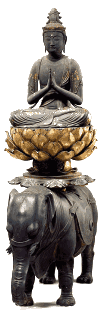
Fugen atop elephant
13th Century
Sanjūsangendō in Kyoto
|
|
 2. Fugen Bosatsu 2. Fugen Bosatsu
Jp. = Fugen Bosatsu 菩薩菩薩
Chn. = Pǔxián Púsà 菩薩菩薩
Skt. = Samantabhadra समन्तभद्र
Éméi shan (Emei Shan) 峨眉山 is Fugen's holy mountain in Sichuan Province, China. Éméi Shan is pronounced "Gabisan"in Japan.
Fugen is known as the "Great Conduct" Bodhisattva, for Fugen teaches that action and conduct (behavior) are equally important as thought and meditation. Fugen encourages people to diligently practice the Buddhist precepts of charity, moral conduct, patience, and devotion. Fugen made ten vows for practicing Buddhism, and is the protector of all those who teach the Dharma (Buddhist Law).
Fugen is often depicted on an elephant (traditionally a white elephant with six tusks). The six tusks represent overcoming attachment to the six senses, while the elephant symbolizes the power of Buddhism to overcome all obstacles. In artwork of Mahayana traditions, Fugen is often shown holding the wish-fulfilling jewel or a lotus bud, but in artwork of the esoteric sects, Fugen is commonly seated on a lotus petal rather than atop an elephant. Fugen often appears with Monju Bosatsu flanking the Historical Buddha (Shaka) in Japanese artwork known as the Shaka Triad (Shaka Sanzon 釈迦三尊).


|
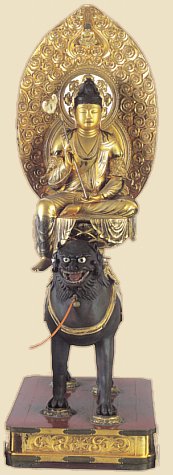
Monju Bosatsu riding lion.
12th century, Chusonji Temple
Photo from magazine
Nihon no Bi no Meguru #35
|
|
 3. Monju Bosatsu 3. Monju Bosatsu
Jp. = Monju Bosatsu 文殊菩薩
Chn. = Wén Shū Púsà 文殊菩薩
Skt. = Mañjuśrī मञ्जुश्री
Wutai shan 五臺山 is Monju's holy mountain in Shanxi 山西 China. In Japan, Monju is often depicted with five curls in hair (sometimes with one, three, six, or eight). The five symbolize the five wisdom peaks 五智 of China’s Mt. Wutai 五臺 (Jp. = Godai).
One who is noble and gentle. Monju is the embodiment of wisdom. Images of Monju were introduced into Japan by Chinese monks who, during a voyage to Wutaishan, learned that Manjusri was reincarnated in the person of the Japanese monk Gyōki, and so went to Nara in 736. One of these monks, Bodhisena (Japanese Bodaisenna), succeeded Gyōki as director of the Buddhist community of the Tōdai-ji Temple in Nara in 751 or 752. In turn, another monk named Ennin traveled to China to Mt. Wutai (Monju’s holy mountain in China) in the year 840, during a journey that lasted nine years from 838 to 847, and brought back scriptures and images of this deity.
Monju Bosatsu, along with Fugen Bosatsu (Samantabhadra), are disciples of the Historical Buddha. In Japan, the two often appear with the Historical Buddha in a grouping called Shaka Sanzon, “the three venerables of Sakyamuni.” also known as the Shaka Triad. Monju represents wisdom, intelligence, willpower, mastery of the Dharma, an infallible memory, mental perfection, and eloquence. This deity, known in India by the doctrines of the Theravada, is identified with the King of Gandharva -- Pancasikha. Monju Bosatsu also appears in many Mahayana texts.
Monju is often represented in India and Tibet, in China and Japan, and in Nepal, which tradition claims Monju founded upon his arrival from China. Monju’s images appear only late in the sixth century in Central Asia and on a few Chinese stele associated with Vimalakirti (Japanese = Yuima Koji).


|
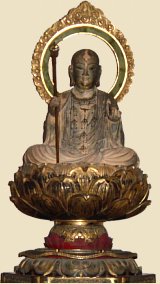
Jizo, Kamakura Era
Jufuku-ji Temple. Now kept at
Tsurugaoka Hachimangu
National Museum in Kamakura
|
|
 4. Jizō Bosatsu 4. Jizō Bosatsu
Jp. = Jizō Bosatsu 地蔵菩薩
Chn. = Dìzàng Púsà
Skt. = Kṣitigarbha क्षितिघर्भ
Jǐuhuá shan 九華山 is Jizō's holy mountain in Anhui 安徽 Province, China. Jǐuhuá shan is pronounced “Kukesen” in Japanese. One of the most beloved of all Japanese divinities, Jizō works to ease the suffering and shorten the sentence of those serving time in hell, to deliver the faithful into Amida’s western paradise (where inhabitants are no longer trapped in the six states of desire and karmic rebirth), and to answer the prayers of the living for health, success, children, and all manner of petitions. In modern Japan, Jizō is a savior par excellence, a friend to all, never frightening even to children, and his/her many manifestations -- often cute and cartoon-like in contemporary times -- incorporate Taoist, Buddhist, and Shintō elements.
Jizō vowed to remain among us doing good works and to help and instruct all those spinning endlessly in the six realms of suffering, especially the souls of the departed who are undergoing judgment by the Ten Kings of Hell (thus explaining why Jizō statues are commonly found in Japanese graveyards). Jizō promises to unceasingly fulfill these tasks in the eons-long interval between the death of the Historical Buddha and the arrival of Miroku Buddha (the Future Buddha). Miroku is scheduled to arrive, according to Japan’s Shingon 真言 sect of Esoteric Buddhism (Mikkyō 密教), about 5.6 billion years from now, to bestow universal salvation on all beings.

Mayahana Buddhism -- The Bosatsu Concept
Mahayana Buddhism (also called the “Greater Vehicle”) proclaims the existence of countless Bosatsu (Bodhisattva) who act as universal saviors for all living beings. To Buddhist followers in Japan, who are mostly of the Mahayana tradition, “compassion” is the defining value of the Bosatsu concept. Throughout the Asian region, the Four Bosatsu of Compassion are among the most widely known Buddhist saviors.
The term “Bodhisattva” was originally used to refer to the Historical Buddha before he attained enlightenment. Thereafter, the term was also used to refer to Miroku (Skt. Maitreya), the Buddha of the Future. With the spread of Mahayana Buddhism, however, the term came to mean one who achieves enlightenment but delays Buddhahood, remaining instead on earth to help all sentient beings attain salvation. In the present age (our current age), Miroku appears only as a Bosatsu, one who has delayed Buddhahood, one who as remained behind to benefit others. This latter concept was vigorously promoted by Mahayana adherents to differentiate it from the Theravada concept of Arhat. The Arhat is also an enlightened being, but according to Mahayana believers, the Theravada Arhat possesses an inferior, selfishly attained enlightenment, one based on "benefitting self" -- for the Theravadins emphasize the monastic life, the forsaking of secular pleasures, the focusing of all one’s energies on achieving individual liberation. The Bodhisattva of Mahayana traditions, however, is motivated entirely by compassion, by the desire to "benefit others" -- indeed, the highest aspiration of the Mahayana Bodhisattva is to save all sentient beings.
Bodhisattva has a third meaning as well in Mahayana traditions -- it refers to anyone who sincerely seeks to save others while pursuing the path of enlightenment. Essentially, anyone who decides to pursue the Buddhist path can be called a Bodhisattva, and many Mahayanans believe there are countless bodhisattvas on earth at any moment. Whereas Theravada Buddhism stresses the monastic life -- the monk's life -- as the only path to salvation (Arhatship), the Mahayana school says anyone, including laity, can attain Buddhahood by practicing the Bodhisattva values. For more on these different interpretations, please click here.

|
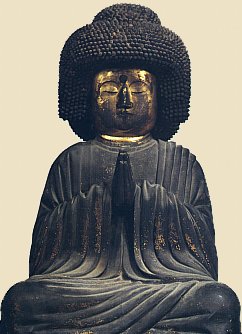
Gokō Shii Amida 五刧思惟阿弥陀 (aka Hōzō Bosatsu). Tōdaiji Temple (Nara), 13th Century.
Hōzō practiced for a long time (five kapla) before attaining enlightenment, and is thus shown with thick hair. One kalpa (Jp. = Kō) is the period required to empty a ten-square mile city of poppy sees, if one seed were removed every three years. <Source: Enlightenment Embodied, The Art of the Japanese Buddhist Sculptor (7th - 14th Centuries). Japan Society, 1997. ISBN 0-913304-43-3.
|
|
 Hōzō Bosatsu Hōzō Bosatsu
(aka Amida Nyorai)
Skt. Dharmakara. The Sutra of Infinite Life (Jp. = Muryojukyō 無量壽經) records the discourses delivered by the Historical Buddha at Vulture Peak in Rajagriha (India), where he speaks of the 48 vows made by Hōzō Bosatsu 法蔵菩薩 (also spelled Hozo or Houzou) to help all sentient beings achieve salvation. As a human, Hōzō was a king who gave up his throne after hearing the teachings of Lokesvararaja Buddha ((Sejizaiō Butsu 自在王佛).
After eons of practice, he made 48 vows 四十八願 and thereafter achieved Buddhahood, becoming known as Amida, the Buddha of Infinite Life. Those who believe in Amida will be reborn in the Buddha Land of Perfection (the “Pure Land”). Of the 48 vows, the 18th vow is most important. In this vow, Hōzō Bosatsu aspires for the universal salvation of all beings. It reads:
"Upon my attainment of Buddhahood, if sentient beings in the ten quarters -- who have sincerity of heart, hold faith, and wish to be born in my land -- repeat my name up to ten times, yet are unable to be reborn in my land, then may I fail to obtain enlightenment."
The 48 vows of Hōzō Bosatsu have survived into modern times, and variations on the vows are used by laity, nuns, and monks in Tibet, China, and Japan.

LEARN MORE
  Buddhist-Artwork.com, our sister site, launched in July 2006. This online store sells quality hand-carved wooden Buddha statues and Bodhisattva statues, especially those carved for the Japanese market. It is aimed at art lovers, Buddhist practitioners, and laity alike. Just like this site (OnmarkProductions.com), it is not associated with any educational institution, private corporation, governmental agency, or religious group. Buddhist-Artwork.com, our sister site, launched in July 2006. This online store sells quality hand-carved wooden Buddha statues and Bodhisattva statues, especially those carved for the Japanese market. It is aimed at art lovers, Buddhist practitioners, and laity alike. Just like this site (OnmarkProductions.com), it is not associated with any educational institution, private corporation, governmental agency, or religious group.
RESOURCES
- JAANUS. Japanese Architecture and Art Net Users System. Outside link. No longer online. A wonderful online dictionary that included many details on Kannon Bodhisattva in Japanese art. Also included separate entries on many Kannon manifestations in Japan.
- See Bibliography for our complete list of resources on Japanese Buddhism, or visit any site page and scroll to the bottom for detailed resources on that specific deity or topic.
- A Dictionary of Chinese Buddhist Terms. With Sanskrit & English Equivalents. Plus Sanskrit-Pali Index. By William Edward Soothill & Lewis Hodous. Hardcover, 530 pages. Published by Munshirm Manoharlal. Reprinted March 31, 2005. ISBN 8121511453.
- Butsuzō-zu-i 仏像図彙, the “Collected Illustrations of Buddhist Images.” Published in 1690 (Genroku 元禄 3). One of Japan’s first major studies of Buddhist iconography. Hundreds of pages and drawings, with deities classified into approximately 80 (eighty) categories. Modern-day reprints are available at this online store (J-site).
- Mandara Zuten 曼荼羅図典 (Japanese Edition). The Mandala Dictionary. 422 pages. First published in 1993. Publisher Daihorinkaku 大法輪閣. Language Japanese. ISBN-10: 480461102-9. Available at Amazon.
- Kokugakuin University Shinto Online Dictionary
- Digital Dictionary of Chinese Buddhism (C. Muller; login "guest")
- Buddhism: Flammarion Iconographic Guides, by Louis Frederic, Printed in France, ISBN 2-08013-558-9, First published 1995. A highly illustrated volume, with special significance to those studying Japanese Buddhist iconography. Includes many of the myths and legends of mainland Asia as well, but its special strength is in its coverage of the Japanese tradition. Hundreds of accompanying images/photos, both B&W and color.
MUSEUMS, PHOTO ARCHIVES

Last Update = April 9, 2011 (major rewrite)
|
|